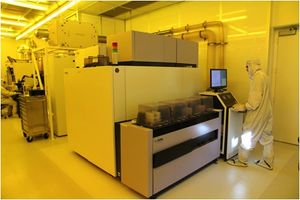Stepper 3 (ASML DUV)
| |||||||||||||||||||||||
About
The ASML 5500 stepper is a 248nm DUV stepper for imaging dense features down to below 200nm and isolated line structures down to below 150nm. Overlay accuracy is better than 30nm.
The system is configured for 4” wafers and, with staff support, mounted pieces down to 14mm in size can be exposed using a 4” wafer as a carrier. The system is designed for high throughput, so shooting multiple 4" wafers is extremely fast. Additionally, exposure jobs are highly programmable, allowing for very flexible exposures of multiple aligned patterns from multiple masks in a single session, allowing for process optimization of large vs. small features in a single lithography.
The full field useable exposure area is limited to the intersection of a 31mm diameter circle and a rectangle of dimensions 22mm x 27mm. Users have stitched multiple photomasks together with success. See the Mask Making Guidelines page for more info on exposure field sizes and how to order your mask plates.
Resists Used (see PhotoLith. Recipes for full process info):
- UV210-0.3 - Positive: 300nm nominal thickness
- UV6-0.8 - Positive: 800nm nominal thickness
- UV26-2.5 - Positive: 2.5um nominal thickness
- UVN2300-0.5 - Negative: 500nm nominal thickness
- DUV42P-6/DS-K101 - Bottom Anti-Reflective Coatings “BARC”
- PMGI/LOL1000/LOL2000 - Underlayers
AZ300MIF Developer for all processes
Process Information
- Process Recipes Page > "Stepper 3" - Established recipes and corresponding linewidths, photoresists etc.
- Sample size: 100 mm wafers with SEMI std. major flat
- Piece-parts process is possible but difficult - contact staff for info
- Alignment Accuracy: < 50 nm
- Minimum Feature Size: ≤150 nm isolated lines, ≤200 nm dense patterns
- To achieve ≤200nm features with high uniformity, we recommend wafers with total thickness variation (TTV) ≤5µm, and designing your CAD with a smaller Image Size for the high-res. feature.
- Maximum Wafer Thickness: 1.1 mm
- Maximum Wafer Bow: approx. 100 µm. (4-inch diam.)
- Near this value, and the job may fail or lose the wafer inside the machine due to wafer vacuum error. Substrate material and substrate thickness affect this limit.
Operating Procedures
- Standard Operating Procedures - Exposing wafers, loading reticles, focus/exposure matrix
- Focus-Exposure Matrix - used for calibrating sensitive exposure parameters
- Troubleshooting & Calibration Check
- Common errors/solutions, System Calibration Verification (aka. IQC)
- ASML 5500: Recovering from an Error/Wafer Retrieval
- How to abort the job and recover your wafer.
- Job Programming- Simplified - Full Wafers
- Job Programming - Full
- Mask Making Guidelines
- All the info you need to design and order a reticle for this system.
Online Video Trainings
These video trainings have bookmarks to skip to specific sections - use them as reference.
Remember, you are NOT authorized to use the system until a supervisor grants you access.
Design & Fabrication Tools
- Mask Making Guidelines - All the info you need to design and order a reticle for this system.
- Templates and CAD help - on the above page, CAD files and spreadsheets to help you design/program.
- ASML Job Creator - Python scripts for generating ASML Job Files.
- This scriptable job programming is now available - contact the supervisor if interested.
- UCSB Test Reticles - Alignment Markers, Resolution Testing etc.
Software Options
The Following software options have been installed on the machine.
- Shifted Measurement Scans - better tilt/level measurement locations for edge-die. Simply enable the Checkbox in your job file.
- Compound Image Design - flexible Image Distribution: grouping of Images with shifts, duplicate instances of Images in each Cell.
- Job Creator - create binary ASML job files from ASCII text files. Python scripting capabilities using this option are currently implemented, contact the supervisor for more info.
Recipes
See the Recipes > Lithography > Stepper Recipes > Stepper #3 page for starting processes for various photoresists, including Dose/Focus values.
Litho. recipes for all our photolith. tools can be found on the Photolithography Recipes page.
Service Provider
- ASML - ASML performs quarterly periodic maintenance and provides on-demand support.
